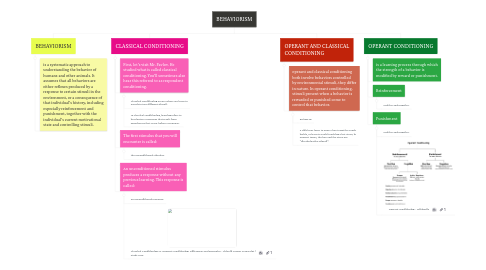BEHAVIORISM
af Evy Rodrigez


1. BEHAVIORISM
1.1. is a systematic approach to understanding the behavior of humans and other animals. It assumes that all behaviors are either reflexes produced by a response to certain stimuli in the environment, or a consequence of that individual's history, including especially reinforcement and punishment, together with the individual's current motivational state and controlling stimuli.
2. CLASSICAL CONDITIONING
2.1. First, let's visit Mr. Pavlov. He studied what is called classical conditioning. You'll sometimes also hear this referred to as respondent conditioning.
2.1.1. Classical conditioning occurs when you learn to associate two different stimuli.
2.1.2. In classical conditioning, learning refers to involuntary responses that result from experiences that occur before a response.
2.2. The first stimulus that you will encounter is called:
2.2.1. the unconditioned stimulus.
2.3. An unconditioned stimulus produces a response without any previous learning. This response is called:
2.3.1. an unconditioned response.
2.3.2. Classical Conditioning vs. Operant Conditioning: Differences and Examples - Video & Lesson Transcript | Study.com
3. OPERANT AND CLASSICAL CONDITIONING
3.1. operant and classical conditioning both involve behaviors controlled by environmental stimuli, they differ in nature. In operant conditioning, stimuli present when a behavior is rewarded or punished come to control that behavior.
3.1.1. EXAMPLE
3.1.2. a child may learn to open a box to get the candy inside, or learn to avoid touching a hot stove; in operant terms, the box and the stove are "discriminative stimuli".
4. OPERANT CONDITIONING
4.1. is a learning process through which the strength of a behavior is modified by reward or punishment.
4.2. Reinforcement
4.2.1. Positive and negative.
4.3. Punishment
4.3.1. Positive and negative.
4.3.2. Operant conditioning - Wikipedia

